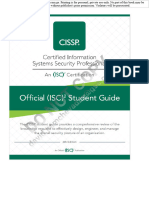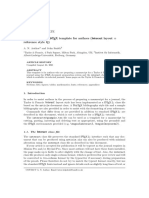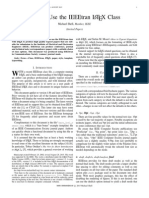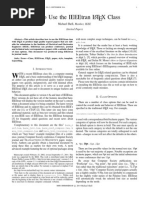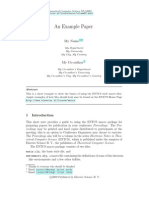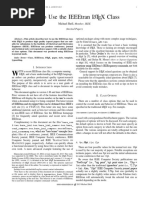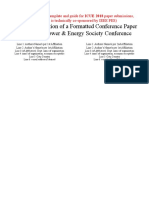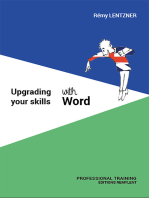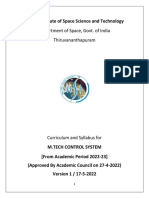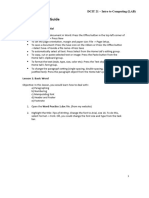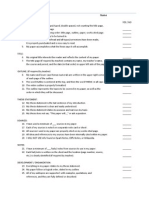Biomguide
Biomguide
Uploaded by
RajeshJosephAbrahamEdasseriathuCopyright:
Available Formats
Biomguide
Biomguide
Uploaded by
RajeshJosephAbrahamEdasseriathuOriginal Description:
Original Title
Copyright
Available Formats
Share this document
Did you find this document useful?
Is this content inappropriate?
Copyright:
Available Formats
Biomguide
Biomguide
Uploaded by
RajeshJosephAbrahamEdasseriathuCopyright:
Available Formats
BIOMETRICS AUTHOR SUBMISSION GUIDE:
SETTING UP YOUR L
A
T
E
X2
FILES
This guide explains the use of the biom document class le for L
A
T
E
X2 . This document class allows authors to
prepare manuscripts for submission to Biometrics, the nal appearance and layout of which is that of a typeset article
appearing in the journal. Authors should use the document class to prepare a postscript or PDF version of their papers
for submission for consideration by the editors, as the Biometrics Central Editorial Oce and Blackwell Publishing do
not have access to L
A
T
E
X2 software and therefore cannot process L
A
T
E
X2 source les directly.
The biom class le is based on the mn style le, which in turn is based on article style as discussed in Lamports
L
A
T
E
X manual (L
A
T
E
X: A Document Preparation System, Addison Wesley, Reading, Mass., 1994. ISBN 0201529831).
Commands that dier from the standard L
A
T
E
X interface, or that are provided in addition to the standard interface,
are explained in this guide. This guide is not a substitute for a comprehensive L
A
T
E
X manual itself. Authors planning
to prepare their papers using L
A
T
E
X are advised to use biom.cls as early as possible in the creation of their les so as
to avoid possible conicts that may emerge upon switching to the document class later.
Distributed with the biom.cls le are the L
A
T
E
X source for three specimen (example) articles, biomsample.tex
and biomsample bib.tex, whose content is nonsensical but which exhibit several features of the document class; and
biomsample2.tex, which uses the document class to typeset an actual, previously-published Biometrics article. Also
included is the le biomtemplate.tex, which authors may use as a template for creating the L
A
T
E
X source for their own
manuscripts. The le biomtemplate.tex is heavily documented with comments that address many issues of convention
and style. The distribution also includes a custom package, endrotfloat.sty, which is used by biom.cls when tables
presented in landscape model are included in a document (see Section 2.2). Additional L
A
T
E
X packages may be required to
implement some features discussed in this guide. These packages are noted in the relevant sections of this guide. If these
packages are not already incorporated in your local distribution of L
A
T
E
X they may be obtained from the Comprehensive
T
E
X Archive Network (CTAN) at http://www.ctan.org/. Finally, the distribution also includes additional les of
interest to users of BiBTeX, discussed in Section 4.7.3.
1. The BIOM Document Class
The use of L
A
T
E
X document classes allows a simple change of class to transform the appearance of your document. The
biom class le preserves the standard L
A
T
E
X interface such that any document that can be produced using the standard
L
A
T
E
X article class can also be produced with the biom class le. However, the measure (or width of text) is broader
than the default for article, and even narrower than for the A4 style.
It is likely that, should your article be accepted for publication, the nal formatting of will change slightly from that
produced when you yourself process it using biom.cls. For this reason, we ask that you ignore details such as slightly
long lines, page stretching, or gures falling out of synchronization, because these details can be dealt with at a later
stage by the publisher. Please also use symbolic references (\ref) in order to protect against late changes of order of
sections, equations, etc.
All papers submitted to Biometrics should be prepared using the referee option in the documentclass
command, as discussed in Section 2. This option produces a version of the manuscript suitable for review by editors and
referees, obeying the journal convention of 1 inch margins, 25 lines per page, and 12 point type. Submitted manuscripts
prepared without invoking the referee option will be returned to the authors for reformatting.
2 SETTING UP YOUR L
A
T
E
X2 FILES
2. Using the BIOM Class File
If the le biom.cls is not already in the appropriate system directory for L
A
T
E
X les, either arrange for it to be put
there or copy it to your working directory. The biom document class is implemented as a complete class, not a document
style option. In order to use the Biometrics document class, replace article by biom in the \documentclass command
at the beginning of your document; that is,
\documentclass{article}
is replaced by
\documentclass{biom}
In general, the following standard document style options should not be used with the biom class le:
(1) 10pt, 11pt, 12pt unavailable;
(2) twoside (no associated style le) twoside is the default;
(3) fleqn, leqno, titlepage should not be used (fleqn is already incorporated into the Biometrics style);
(4) twocolumn is not necessary as it is the default style.
The biom class le has been designed to operate with the standard version of lfonts.tex that is distributed as part
of L
A
T
E
X. Attempt to typeset the specimen or template les mentioned above. If you encounter font problems, you might
investigate whether a non-standard version of lfonts.tex has been installed in your system.
Authors using L
A
T
E
X wishing to create PDF les with smooth fonts are advised to read Adobe FaxYI Document
Number 131303 by Kendall Whitehouse. Type 1 PostScript versions of the Computer Modern fonts are now freely
available and are normally installed with new T
E
X/L
A
T
E
X software.
2.1 Additional Document Style Options
The following additional style options are available with the biom class le:
onecolumn to be used only when two-column output is unable to accommodate long equations;
doublespacing this will double-space your article by setting \baselinestretch to 2.
referee this enables the production of a version of the manuscript suitable for review by editors and referees. All
papers submitted for publication should be prepared using this option.
galley no running heads, no attempt to align the bottom of columns.
useAMS this enables the production of upright Greek characters , and .
usedcolumn this uses the package le dcolumn.sty to dene two new types of column alignment for use in tables.
usenatbib this uses Patrick Dalys natbib package for cross-referencing.
usegraphicx this enables the use of the graphicx package for inclusion of gures. Note that the standard L
A
T
E
X
graphics package graphicx.sty is required in order to use the usegraphicx option.
Please place any additional command denitions at the very start of the L
A
T
E
X le, before the \begin{document}.
For example, user-dened \def and \newcommand commands that dene macros for technical expressions used in the
manuscript should be placed here. Other author-dened macros should be kept to a minimum. Please do not include
macros that are not used in the document. Also, please do not customize the Biometrics macros or class le, or redene
macros that are already in the class le, and please do not include additional denitions unless they are actually used
in the paper.
2.2 Landscaping Pages
If a table is too wide to t the standard measure, it may be turned, with its caption, 90 degrees. Landscape tables
cannot be produced directly using the biom class le because T
E
X itself cannot turn the page, and not all device drivers
provide such a facility. The following procedure can be used to produce such pages.
(1) Use the package rotating in your document (see the specimen and template les for examples) and change the
coding from
\begin{table}...\end{table}
to
\begin{sidewaystable}...\end{sidewaystable}
environments in your document to turn your table on the appropriate page of your document. For instance, the
SETTING UP YOUR L
A
T
E
X2 FILES 3
following code prints a page with the running head, a message half way down and the table number towards the
bottom.
\begin{sidewaystable}
\caption{Landscape table to go here.}
\label{landtab}
\end{sidewaystable}
3. Additional Facilities
In addition to all the standard L
A
T
E
X design elements, the biom class le includes a number of custom features. These
are noted throughout this guide. Once you have used these additional biom.cls facilities in your document, do not
process it with a standard L
A
T
E
X class le.
3.1 Titles and Authors Name(s)
The title of the article and the authors name and aliation (or authors names and aliations) are used at the beginning
of the article for the main title. At the beginning of your article, the title should be generated in the usual way using
the \maketitle command. See the specimen les and the template le for demonstration, and see the following sections
for more details.
3.2 Running Headline
A shortened version of the title of the manuscript will be used as a running headline at the top of every odd-numbered
page. Although the full manuscript title can run to several lines of text, the running headline must be a single line.
Moreover, new line commands (e.g. \\) are not acceptable in a running headline. To enable you to specify a short running
head, the standard \title command has been extended to take an optional argument to be used as the running headline.
The running headlines can be produced using the following code:
\title[This is a Shortened Article Title]
{This is an Example of a Rather Long and Drawn Out Full-Length
Article Title}
For even-numbered pages, if you include the \pubyear and \artmonth commands, the running head will show the
month and year you specify; for example:
\pubyear{2008}
\artmonth{December}
will produce Biometrics, December 2008 on each even-numbered page.
The \pagestyle and \thispagestyle commands should not be used. Similarly, the commands \markright and
\markboth should not be necessary.
3.3 Author Names and Aliations
The \author, \email, and \emailx commands may be used in combination to produce author/aliation displays
consistent with the Biometrics style conventions. The \email command produces the email address specied with an
asterisk * superscript, so that it may be footnoted in the author list. The \emailx command produces the email
address with no such superscript.
The following are examples of how to create author and aliation displays consistent with the journal conventions
for several dierent scenarios. These examples appear in the template le and may be customized for your document.
(1) For a single authored manuscript. Use \emailx so that no asterisk footnoting for the email address will be produced.
\author{John Author\emailx{email@address.edu} \\
Department of Statistics, University of Warwick, Coventry CV4 7AL, U.K.}
(2) For two authors from the same institution, with both emails, use \email to produce the asterisk footnoting for each
email address.
4 SETTING UP YOUR L
A
T
E
X2 FILES
\author{John Author$^{*}$\email{author@address.edu} and
Kathy Authoress$^{**}$\email{email2@address.edu} \\
Department of Statistics, University of Warwick, Coventry CV4 7AL, U.K.}
(3) For exactly two authors from dierent institutions, both with email addresses, use \emailx here so that no asterisk
footnoting for the email addresses is produced.
\author
{John Author\emailx{author@address.edu} \\
Department of Statistics, University of Warwick, Coventry CV4 7AL, U.K.
\and
Kathy Author\emailx{anotherauthor@address.edu} \\
Department of Biostatistics, University of North Carolina at Chapel Hill,
Chapel Hill, North Carolina, U.S.A.}
(4) For three or more authors from same institution with all emails displayed and footnoted using asterisks, use \email
as follows
\author{John Author$^*$\email{author@address.edu},
Jane Author$^{**}$\email{jane@address.edu}, and
Dick Author$^{***}$\email{dick@address.edu} \\
Department of Statistics, University of Warwick, Coventry CV4 7AL, U.K}
(5) For three or more authors from same institution with one corresponding email displayed, use \email.
\author{John Author$^*$\email{author@address.edu},
Jane Author, and Dick Author \\
Department of Statistics, University of Warwick, Coventry CV4 7AL, U.K}
(6) For three or more authors, with at least two dierent institutions and more than one email displayed, use \email
as follows
\author{John Author$^{1,*}$\email{author@address.edu},
Kathy Author$^{2,**}$\email{anotherauthor@address.edu}, and
Wilma Flinstone$^{3,***}$\email{wilma@bedrock.edu} \\
$^{1}$Department of Statistics, University of Warwick, Coventry CV4 7AL, U.K \\
$^{2}$Department of Biostatistics, University of North Carolina at
Chapel Hill, Chapel Hill, North Carolina, U.S.A. \\
$^{3}$Department of Geology, University of Bedrock, Bedrock, Kansas, U.S.A.}
(7) For three or more authors with at least two dierent institutions and only one email displayed, use \email.
\author{John Author$^{1,*}$\email{author@address.edu},
Wilma Flinstone$^{2}$, and Barney Rubble$^{2}$ \\
$^{1}$Department of Statistics, University of Warwick, Coventry CV4 7AL, U.K \\
$^{2}$Department of Geology, University of Bedrock, Bedrock, Kansas, U.S.A.}
Note that, in all of these examples, you must create the footnotes manually. If your conguration of authors, aliations,
and email addresses is not demonstrated explicitly above, please review recent issues of Biometrics to nd an instance
of your conguration, and, using the examples above to assist you, make sure that your display is consistent with the
convention shown in the journal for your conguration.
3.4 Abstracts and Key Words
The abstract should be enclosed within an abstract environment, followed immediately by the key words, presented in
alphabetical order, enclosed in a keywords environment. For example:
\begin{abstract}
This guide is for authors who are preparing papers for
\textit{Biometrics}, published by the International Biometric
Society}, using the \LaTeXe\ document preparation system and the {\tt
SETTING UP YOUR L
A
T
E
X2 FILES 5
biom} class file.
\end{abstract}
\begin{keywords}
\verb"biom.cls"\; Class files; \LaTeXe\,; Sample text; User guide.
\end{keywords}
\maketitle
\section{Introduction}
The headings Summary: and Key words: are created automatically, and the key words are followed by vertical
space. For example,
\begin{abstract}
:
\end{abstract}
\begin{keywords}
:
\end{keywords}
\maketitle
\section{Introduction}
4. Some Guidelines for Using Standard Facilities
The following notes may help you achieve the best eects with the biom class le.
4.1 Sections
L
A
T
E
X2 provides four levels of section headings, and they are all dened in the biom class le:
\section
\subsection
\subsubsection
\paragraph
However, the use of \subsubsection and \paragraph headings is generally discouraged. In the \section and \subsection
headings, the rst letter of each major word (except for articles, conjunctions, etc.) should be capitalized.
Section numbers are automatically generated for section, subsection, subsubsection and paragraph headings, and
headings are displayed in the typeface consistent with the journal style for that type of heading.
4.2 Lists
The biom class le provides unnumbered lists using the description environment for example,
First unnumbered item has no label and is indented from the left margin if it wraps to a second line, which in this
example it denitely does
Second unnumbered item.
Third unnumbered item which has no label
was produced by:
\begin{description}
\item First unnumbered item...
\item Second unnumbered item.
\item Third unnumbered item which has no label
\end{description}
6 SETTING UP YOUR L
A
T
E
X2 FILES
The biom class le also provides bullet/itemize lists using the itemize environment for example,
First unnumbered item has no label and is indented from the left margin if it wraps to a second line, which in this
example it denitely does
Second unnumbered item.
Third unnumbered item which has no label and is indented from the left margin.
was produced by:
\begin{itemize}
\item First unnumbered item which has no label and is indented from the left margin which has no label.
\item Second unnumbered item.
\item Third unnumbered item which has no label and is indented from the left margin.
\end{itemize}
Numbered lists is also provided in biom class le using the enumerate environment for example,
(1) The attenuated and diluted stellar radiation. The attenuated and diluted stellar radiation;
(2) Scattered radiation, and
(3) Reradiation from other grains.
was produced by:
\begin{enumerate}
\item The attenuated and diluted stellar radiation. The attenuated and diluted stellar radiation;
\item Scattered radiation, and
\item Reradiation from other grains.
\end{enumerate}
Note here the the standard form of the enumerate environment has been replaced by a style consistent with the
Biometrics convention for numbered lists. The following example shows how to obtain the standard form:
1. The attenuated and diluted stellar radiation;
2. Scattered radiation, and
3. Reradiation from other grains.
was produced by:
\begin{enumerate}
\item[1.] The attenuated and diluted stellar radiation;
\item[2.] Scattered radiation, and
\item[3.] Reradiation from other grains.
\end{enumerate}
4.3 Figures
The biom class le will cope with most positioning of your gures in the nal version of your manuscript when it is
prepared using the default journal two-column, single-spaced format. You should place gures close to (but usually after)
the points in the text where they are rst referenced. When the referee option is used, all gures will be displayed at
the end of the document, but you should nonetheless place them as for the nal version. Although you are preparing an
article for submission using the referee option, viewing your article in the default, two-column format will show you
whether or not your gures are being placed correctly.
You should not normally use the optional positional qualiers on the figure environment that would override
these decisions. See http://www.blackwellpublishing.com/bauthor/illustration.asp for details regarding submis-
sion guidelines for securing print-quality of artwork. Figure captions should be below the gure itself, therefore the
\caption command should appear after the gure or space left for an illustration. For example, Figure 1 is produced
using the following commands:
\begin{figure}
\centerline{%
SETTING UP YOUR L
A
T
E
X2 FILES 7
200 300 400 500 600
1
.
0
0
.
0
1
.
0
2
.
0
Time (days)
E
s
t
im
a
t
e
d
c
o
e
f
f
ic
ie
n
t
(a)
200 300 400 500 600
1
.
0
0
.
0
0
.
5
Time (days)
E
s
t
im
a
t
e
d
c
o
e
f
f
ic
ie
n
t
(b)
200 300 400 500 600
2
.
5
1
.
5
0
.
5
0
.
5
Time (days)
E
s
t
im
a
t
e
d
c
o
e
f
f
ic
ie
n
t
(c)
200 300 400 500 600
2
.
5
1
.
5
0
.
5
Time (days)
E
s
t
im
a
t
e
d
c
o
e
f
f
ic
ie
n
t
(d)
200 300 400 500 600
0
.
0
0
.
4
0
.
8
1
.
2
Time (days)
E
s
t
im
a
t
e
d
c
o
e
f
f
ic
ie
n
t
(e)
Figure 1. An example gure caption.
\includegraphics[width=50mm]{art/biom_621_f1.eps}}
%% to include a figure, or to leave a blank space
\caption{An example figure caption.}
\label{sample-figure}
\end{figure}
Here, because this document has only one column, the gure spans the entire width. However, when using the
document class with the default two-column option, gures created using \begin{figure}...\end{figure} will appear
in a single column. In order to create a gure that spans across both columns, as is often the case in the journal, you
should instead use \begin{figure*}...\end{figure*}. When your document is processed using the referee option,
all gures will appear across the entire page, regardless of which environment was specied.
Cross-referencing of gures, tables, and numbered, displayed equations using the \label and \ref commands is
strongly encouraged. For example, in referencing Figure 1 above, we used For example, Figure~\ref{sample-figure} is
produced using...
4.4 Tables
The biom class le will cope with most positioning of your tables as well, and, you should place them as with gures
near where you would like them to appear. Again, with the referee option, they will be moved automatically to the
end of the document. You should not normally use the optional positional qualiers on the table environment that
would override these decisions. Table captions should be at the top, therefore the \caption command should appear
above the body of the table.
Commands to redene quantities such as \arraystretch should be omitted in general. For example, Table 1 is
produced using the following commands. Note that \rmn will produce a roman character in math mode. There are also
\bld and \itl, which produce bold face and text italic in math mode.
\begin{table}
\caption{Radio-band beaming model parameters.} \label{symbols}
8 SETTING UP YOUR L
A
T
E
X2 FILES
Table 1
Radio-band beaming model parameters.
Class 1 2 G f c
BL Lacs 5 36 7 4.0 1.0 10
2
10
FSRQs 5 40 11 2.3 0.5 10
2
14
{\begin{tabular*}{\columnwidth}{@{}l@{\extracolsep{\fill}}c@{\extracolsep{\fill}}c
@{\extracolsep{\fill}}c@{\extracolsep{\fill}}c@{\extracolsep{\fill}}c@{\extracolsep{\fill}}c@{}}
\Hline Class & $\gamma _1$ & $\gamma _2$ & $\langle \gamma \rangle$ &
$G$ & $f$ & $\theta _{\rmn{c}}$ \\ \hline BL Lacs &5 & 36 & 7 &
$-4.0$ & $1.0\times 10^{-2}$ & 10$^\circ$ \\ FSRQs & 5 & 40 & 11 &
$-2.3$ & $0.5\times 10^{-2}$ & 14$^\circ$ \\ \hline \end{tabular*}}
\bigskip
\end{table}
As with gures, cross-referencing of tables is encouraged. For example, we would reference Table 1 using
Table~\ref{symbols}.
Also as with gures, you may wish to process your document with the default two-column option to determine
whether or not tables may need to be exteneded over two columns in the journal version of the paper. If you have a
table that is to extend over two columns, you need to use table* instead of table, as for gures.
4.5 Typesetting Mathematics
4.5.1 Displayed mathematics. The biom class le will set displayed mathematics centered in the width of a column
in the nal version of a manuscript, provided that you use the L
A
T
E
X2 standard of open and closed square brackets as
delimiters.
The equation
p
i=1
i = trace(S)
was typeset using the biom class le with the commands
\[
\sum_{i=1}^p \lambda_i = \rmn{trace} (\mathbfss{S})
\]
Displayed equations should not be numbered unless they are referenced in the text. For such referenced equations,
cross-referencing is encouraged. For example,
\begin{equation}
(n-1)^{-1} \sum^n_{i=1} (X_i - \overline{X})^2.
\label{eq:samplevar}
\end{equation}
Equation~(\ref{eq:samplevar}) gives the formula for sample variance.
4.5.2 Long / two column equations. The biom class le provide the option to code long equations in the paper; i.e.,
equations that would be very dicult to display in a single column in the nal version of a manuscript. To code the
long equation, following coding should be followed:
\begin{longequation}
\left(\begin{array}{cc}%
[\tau_i(D-\alpha_iW]^{-1}+(\eta_0I+\eta_1W)[\tau_2(D-\alpha_2W)]^{-1}(\eta_0I+\eta_1W)&
(\eta_0I+\eta_1W)[\tau_2(D-\alpha_2W)]^{-1}\\
{[}\tau_2(D-\alpha_2W)]^{-1}(\eta_0I+\eta_1W)&[\tau_2(D-\alpha_2W)]^{-1}
\end{array}
\right).
SETTING UP YOUR L
A
T
E
X2 FILES 9
\label{eq:samplelongeqn}
\end{longequation}
As with regular displayed equations, long equations that are referenced in the text should be cross-referenced using
the \label and \ref commands. Use of the longequation environment should only be reserved for very unusual
circumstances where it would be impossible for an expression to be displayed in one column broken over several lines.
Most Biometrics papers will not use this feature. You may wish to examine recent issues of the journal for examples
where a longequation was necessary and for example of how they may be avoided in many instances.
In case of long equations, the equation is spread to the adjoining column to enhance readability. To separate the text
in the columns from the equation, two horizontal rules are drawn above and below the equation. The space between
these two rules is variable and is inserted on the basis of the hight of the equation, e.g. 3pc, 4pc, 5pc, ... To align long
equations within two horizontal rules in other column (as per the Biometrics style), the biom class le provides the
option \eqnbreaktop{...}. In \eqnbreaktop{...} the approx height of the long equation should be given, for example,
if the height of the long equation is 5pc then the value coded in \eqnbreaktop should be \eqnbreaktop{5pc}.
4.5.3 Bold math italic / bold symbols. To get bold math italic you should use \bmath, e.g.
\[
d(\bmath{s_{t_u}}) = \langle [RM(\bmath{X_y}
+ \bmath{s_t}) - RM(\bmath{x_y})]^2 \rangle
\]
to produce:
d(stu
) = [RM(Xy +st) RM(xy)]
2
Thus, scriptstyle and scriptscriptstyle sizes will take care of themselves.
4.5.4 Bold greek. Upper and lowercase Greek characters are available in all typesizes.
You can then use these denitions in math mode, as you would normal Greek characters:
\[
\bmath{\alpha_{\mu}} = \bmath\Theta \alpha.
\]
will produce
= .
4.5.5 Upright greek characters. If you prefer upright Greek characters, you can obtain them if you have access to
the American Mathematical Society Euler fonts (version 2.0), but you may not have these. In this case, you will have
to use the normal math italic symbols. If you would like the symbols to appear as upright in the nal version of the
paper (should it be published), you can signal this to the typesetter and make it easier by using the macros \upi, \umu
and \upartial etc. in your text to indicate the need for upright characters, together with the useAMS global option:
(\documentclass[useAMS]{biom}). Characters , and will appear upright only on systems that have the Euler
roman fonts (eurmxx); characters and appear slanted only on systems that have the AMS series A fonts (msamxx).
On systems that do not have these fonts, the standard forms of the characters appear in the printout; however, they
should be correct in the nal typeset paper if the correct L
A
T
E
X commands have been used.
4.6 Acknowledgements and Supplementary Material
Immediately following the end of the main body of the paper, the \backmatter command should be issued. This will
ensure that subsequent formatting of section headings is consistent with the style in Biometrics articles. Two optional
sections may be placed following this command, preceding the bibliography (discussed in the next section).
An optional Acknowledgements section may be included. Authors may wish to thank or acknowledge the contributions
of specic individuals who are not named as authors on the paper, or they may wish to cite a grant that supported the
research being reported in the article.
Following an Acknowledgements section, if any, a Supplementary Materials section should be included if the paper
makes reference to any web-based supplementary material, such as Web Appendices, Web Tables, or Web Figures. See
Information for Authors at http://www.tibs.org/biometrics for more information.
The following gives an example of how these elements should be included:
10 SETTING UP YOUR L
A
T
E
X2 FILES
\backmatter
\section*{Acknowledgements}
The authors wish to thank...
\section*{Supplementary Material}
Web Appendix A, referenced in Section~\ref{s:two}, is available under
the Paper Information link at the \textit{Biometrics} website
\texttt{http:www.tibs.org/biometrics}.
See the template le for an example of the specication of these sections.
4.7 References
References to published literature should be quoted in the text by author and date, e.g., Draine (1978) or (Begelman,
Blandford, and Rees, 1984). Where more than one reference is cited having the same author(s) and date, the letters
a,b,c,. . . should follow the date, e.g., Smith (1988a), Smith (1988b), etc. For papers with exactly three authors, the rst
time the paper is cited, all author names should be used, e.g., Begelman, Blandford, and Rees (1984), and subsequent
citations should use et al., e.g., Begelman et al. (1984). For papers with more than three authors, the rst author
name plus et al. should always be used. In the bibliography list, all authors should be retained.
A recent version of Biometrics should be used as a guide for the style of making citations to literature in the text.
See also the template le.
We discuss three ways for authors to create the reference list and citations in the text.
4.7.1 Do-it-yourself references and citations. One way to create the reference list is to type it yourself. Here is
an example using the thebibliography environment; see also the template le. See the next section for more on the
formatting used below.
\begin{thebibliography}{}
\bibitem[\protect\citeauthoryear{Butcher}{1992}]{bu}
Butcher, J. (1992). Proper multivariate conditional autoregressive models for spatial data
analysis. {\it Biometrics} {\bf 196,} 173.
\bibitem[\protect\citeauthoryear{Blanco}{1991}]{bl}
Blanco, P. (1991). {\it NIFT\/} 2nd edition. Boca Raton, Florida: Chapman and Hall.
\bibitem[\protect\citeauthoryear{Brown and Jones}%
{1989}]{bj} Brown, A. B. and Jones, C. D. (1989). {\it National Sangget Academy}, 2nd edition.
Hoboken, New Jersey: Wiley.
\bibitem[\protect\citeauthoryear{Edelson}{1987}]{eda}
Edelson, R. A. (1987). Using counts to simultaneously estimate
abundance and detection probabilities in a salamander community. {\it
Herpetologica} {\bf 60,} 468--478.
\bibitem[\protect\citeauthoryear{Edelson}{1987}]{edb}
Edelson, R. A. (1988). Using counts to simultaneously estimate
abundance and detection probabilities in a salamander community. {\it
Herpetologica} {\bf 61,} 520--532.
\bibitem[\protect\citeauthoryear{Knuth}{1998}]{kn}
Knuth, D. E. (1998). The \TeX book. Addison-Wesley, Reading, MA.
\bibitem[\protect\citeauthoryear{Kopka and Daly}{1999}]{kd}
Kopka, H. and Daly, P. W. (1999). A Guide to \LaTeX, 3rd edn. Addison-Wesley, Harlow.
\bibitem[\protect\citeauthoryear{Lamport}{1986}]{laa}
Lamport, L. (1986). \LaTeX: A Document Preparation System. Addison--Wesley, New York.
\bibitem[\protect\citeauthoryear{Lamport}{1986}]{lab}
Lamport, L. (1992). \LaTeX: A Document Preparation System. Addison--Wesley, New York.
\bibitem[\protect\citeauthoryear{Mirabel and Sanders}%
SETTING UP YOUR L
A
T
E
X2 FILES 11
{1989}]{ms} Mirabel, I. F. and Sanders, D. B. (1989). Topics
in Stochastic Process. New York: Academic Press.
\bibitem[\protect\citeauthoryear{Misner et al.}%
{1973}]{mtw} Misner, C. W., Thorne, K. S., and Wheeler J. A. (1973). A comparison of smoothing
techniques for CD4 data measured with error in a time-dependent Cox
proportional hazards model. {\it Statistics in Medecine} {\bf 17,} 2061--2077.
\bibitem[\protect\citeauthoryear{Stella and Campana}%
{1991}]{sc} Stella, L. and Campana, S. (1991). Testing hypotheses in the functional linear
model. {\it Scandinavian Journal of Statistics} {\bf 30,} 241--251.
\end{thebibliography}
This code produces the following.
References
Butcher, J. (1992). Proper multivariate conditional autoregressive models for spatial data analysis. Biometrics 196,
173.
Blanco, P. (1991). NIFT 2nd edition. Boca Raton, Florida: Chapman and Hall.
Brown, A. B. and Jones, C. D. (1989). National Sangget Academy, 2nd edition. Hoboken, New Jersey: Wiley.
Edelson, R. A. (1987). Using counts to simultaneously estimate abundance and detection probabilities in a salamander
community. Herpetologica 60, 468478.
Edelson, R. A. (1988). Using counts to simultaneously estimate abundance and detection probabilities in a salamander
community. Herpetologica 61, 520532.
Knuth, D. E. (1998). The T
E
Xbook. Addison-Wesley, Reading, MA.
Kopka, H. and Daly, P. W. (1999). A Guide to L
A
T
E
X, 3rd edn. Addison-Wesley, Harlow.
Lamport, L. (1986). L
A
T
E
X: A Document Preparation System. AddisonWesley, New York.
Lamport, L. (1992). L
A
T
E
X: A Document Preparation System. AddisonWesley, New York.
Mirabel, I. F. and Sanders, D. B. (1989). Topics in Stochanstic Process. New York: Academic Press.
Misner, C. W., Thorne, K. S., and Wheeler J. A. (1973). A comparison of smoothing techniques for CD4 data measured
with error in a time-dependent Cox proportional hazards model. Statistics in Medicine 17, 20612077.
Stella, L. and Campana, S. (1991). Testing hypotheses in the functional linear model. Scandinavian Journal of Statistics
30, 241251.
In this case, the author is responsible for typing the citations to references in the list directly into the text. For
example, These models are discussed by Butcher (1992).
4.7.2 Use of natbib. If the usenatbib global option is specied, Patrick Dalys natbib package will be used for for
cross-referencing (i.e., creating citations in the text). (Note that Patrick Dalys package natbib is required in order to
use the usenatbib option and can be obtained as discussed at the beginning of this guide).
Here, the author should create the bibliography using the thebibliography environment, as in the last section. That
is, items in the reference list must be of the form
\bibitem[\protect\citeauthoryear{author names}{year}]{key}
Text of reference ...
for one-, two- and multi-author papers, or
\bibitem[\protect\citeauthoryear{three author names}{rst author etal }{year}]{key}
Text of reference ..., for three-author papers. See the specimen les for demonstration.
The advantage of using natbib is that citations may then be created automatically as follows. If the usenatbib option
is specied, citations in the text should be in one of the following forms (or one of the additional forms documented
within natbib itself).
\citet{key} produces text citations, e.g., Jones et al. (1990),
\citep{key} produces citations in parentheses, e.g., (Jones et al., 1990)
For three-author papers, a full author list can be forced by putting a * just before the {. To add notes within the
citation, use the form \citep[pre reference text][post reference text]{key} (note that either of pre reference text and
post reference text can be blank).
12 SETTING UP YOUR L
A
T
E
X2 FILES
We recommend that authors use natbib as their standard cross-referencing package, because of the exibility in
citation style that it provides.
4.7.3 Use of BiBTeX. Authors may also use BibTeX to create the reference list and to make citations. We assume
that authors choosing this route are already familiar with the use of BibTeX. Thus, we only review the main idea.
In order to use BibTeX, you must have a .bib le containing the database for your bibliography, and a .bst le,
which is a bibliography style le that produces the reference list according to the conventions incorporated in the le.
Included with the distribution is a .bst le, biometrics.bst, that will ensure that your list of references is placed in
the journal style. This .bst le should be used to ensure that the journal convention are followed.
BibTeX uses your style-independent bibliography database .bib le to produce a list of references, in a customizable
style, from citations in a LaTeX document. L
A
T
E
X2 writes information about the citations and which .bib les to use
in the .aux le. BibTeX reads this le and outputs a .bbl le containing L
A
T
E
X2 commands to produce the reference
list (like those typed manually in the previous sections). One must compile the document again to incorporate the
reference list in the document. In particular, the steps are:
(1) Include the .bst le and .bbl le in your document using the commands \bibliographystyle{biometrics} and
\bibliography{biblio} at the position in the le where the references are to appear (see the le biometrics bib.tex
for a demonstration).
(2) Process your document using L
A
T
E
X (e.g., issue the command latex lename.tex in a Unix or Linux environment)
to update the lename.aux le
(3) Process your document using BibTeX to generate the .bbl le (e.g., issue the command bibtex lename)
(4) Re-process your document using L
A
T
E
X (e.g., reissue latex lename.tex) to incorporate the .bbl in the document
(5) Process one more time using L
A
T
E
X (e.g., latex lename.tex) to generate the cross-references with the generated
bibliography.
We recommend using natbib concurrently with BibTeX to generate the citations in the text using the citation
commands given in the last section. This is illustrated in the specimen le biomsample bib.tex.
5. Appendices
The appendices in this guide were generated by typing:
\appendix
\section{}
\subsection{For Authors}
:
\section{}
\subsection{For Editors}
Thereafter, every \section command will generate a new appendix. Equations will be numbered as, e.g.,
Equations (A.1). Tables and gures in Appendices are strongly discouraged; if these do appear, they will be numbered
without an appendix prex, sequentially following tables and gures appearing in the main body of the text. For
example,
\begin{equation}
n^{-1} \sum^n_{i=1} (X_i - \overline{X})^2.
\label{eq:mle}
\end{equation}
In (\ref{eq:mle}), $n-1$ has been replaced by $n$.
will produce In (A.1),. . .
SETTING UP YOUR L
A
T
E
X2 FILES 13
Table 1
Authors notes.
\title[optional short title]{long title} short title used in running head
\author[optional short author(s)]{long author(s)} short author(s) used in running head
\newauthor starts a new line in the author environment
\begin{abstract}...\end{abstract} for abstract on titlepage
\begin{keywords}...\end{keywords} for keywords on titlepage
\nokeywords if there are no keywords on titlepage
\begin{figure*}...\end{figure*} for a double spanning gure in two-column mode
\begin{table*}...\end{table*} for a double spanning table in two-column mode
\plate{Opposite p.~812, MNRAS, {\bf 261}} used with \thispagestyle{plate} for plate pages
\contcaption{} for continuation gure and table captions
\bmath{math text} Bold math italic / symbols.
\textbfit{text}, \mathbfit{text} Bold text italic (dened in the preamble
of mnsample.tex).
\textbfss{text}, \mathbfss{text} Bold text sans serif (dened in the preamble of
mnsample.tex).
Table 2
Editors notes.
\pagerange{000--000} for catchline, note use of en-rule
\pagerange{L00--L00} for letters option, used in catchline
\volume{000} volume number, for catchline
\pubyear{0000} publication year, for catchline
\journal replace the whole catchline at one go
[doublespacing] documentstyle option for doublespacing
[galley] documentstyle option for running to galley
[landscape] documentstyle option for landscape illustrations
[letters] documentstyle option, for short communications (adds L to folios)
[onecolumn] documentstyle option for one-column
[referee] documentstyle option for 12pt type, 25 lines/page
\bsp typesets the nal phrase This paper has been typeset from a
T
E
X/L
A
T
E
X le prepared by the author.
Appendix
For Authors
Table 1 is a list of design macros which are unique to the Biometrics class and style les. The list displays each macros
name and description.
Appendix
For Editors
The additional features shown in Table 2 may be used for production purposes. The most commonly used of these is
\bsp, which produces the This paper . . . statement. This should be placed at the end of the document.
You might also like
- CISSP Official (ISC) 2 Student Guide 6th EditionDocument1,097 pagesCISSP Official (ISC) 2 Student Guide 6th Editionsemil34581No ratings yet
- Association For Computing Machinery ACM Small Standard Format TemplateDocument10 pagesAssociation For Computing Machinery ACM Small Standard Format Templateemirhan.70.kNo ratings yet
- RMS Titanic - A Modelmaker S ManualDocument4,264 pagesRMS Titanic - A Modelmaker S ManualEduardo Gill0% (2)
- Interact Cad SampleDocument15 pagesInteract Cad SamplerajdeepNo ratings yet
- Taylor and Francis Late Template For Authors Interact Layout Plus Q Reference StyleDocument15 pagesTaylor and Francis Late Template For Authors Interact Layout Plus Q Reference StyleVivek RajNo ratings yet
- InteractcadsampleDocument19 pagesInteractcadsampleIdriss BenkacemNo ratings yet
- Article Template Taylor & Francis L TEX Template For Authors (Interact Layout + NLM Reference Style)Document15 pagesArticle Template Taylor & Francis L TEX Template For Authors (Interact Layout + NLM Reference Style)Victor DanielNo ratings yet
- InteractnlmsampleDocument15 pagesInteractnlmsampleMauro GasparofNo ratings yet
- InteractapasampleDocument16 pagesInteractapasampleMiguel Angel Hernández BenavidesNo ratings yet
- Taylor and Francis Latex Template For Authors Interact Layout Plus Apa Reference StyleDocument16 pagesTaylor and Francis Latex Template For Authors Interact Layout Plus Apa Reference StyleramuNo ratings yet
- Guide Engineering Optimization L TEX Style Guide For Authors (Style 2 + Chicago Author-Date Reference Style)Document17 pagesGuide Engineering Optimization L TEX Style Guide For Authors (Style 2 + Chicago Author-Date Reference Style)skyline1122No ratings yet
- User Manual: Journal Article Latex Authoring TemplateDocument14 pagesUser Manual: Journal Article Latex Authoring TemplateYuki TerazawaNo ratings yet
- Ieeetran HowtoDocument28 pagesIeeetran Howtoc_cohenNo ratings yet
- IOP Latex GuidelinesDocument30 pagesIOP Latex GuidelinesMauro SansanaNo ratings yet
- Achemso DemoDocument7 pagesAchemso DemoannerivervalleyNo ratings yet
- LATEX Guidelines For Elsevier Major Reference WorksDocument3 pagesLATEX Guidelines For Elsevier Major Reference WorksrogerdscribdNo ratings yet
- Ejoam TemplateDocument22 pagesEjoam TemplateJack FisherNo ratings yet
- How To Use The Ieeetran L Tex Class: Michael Shell, Member, Ieee (Invited Paper)Document27 pagesHow To Use The Ieeetran L Tex Class: Michael Shell, Member, Ieee (Invited Paper)uouNo ratings yet
- Latex GuideDocument27 pagesLatex GuideRakibul Hasan SagorNo ratings yet
- MitthesisDocument8 pagesMitthesisBharat in SpainNo ratings yet
- Iop Latex GuidelinesDocument30 pagesIop Latex GuidelinesgooliNo ratings yet
- Ieeephot HowtoDocument10 pagesIeeephot HowtoHailton AntunesNo ratings yet
- User ManualDocument14 pagesUser ManualBlaine DaveNo ratings yet
- Custom Latex ClassDocument14 pagesCustom Latex ClassEpic WinNo ratings yet
- An Example Paper: My NameDocument8 pagesAn Example Paper: My NameRifqi AdzkaroNo ratings yet
- Your Project Title: (EECS 149/249A Class Project)Document4 pagesYour Project Title: (EECS 149/249A Class Project)Alex ChongNo ratings yet
- How To Use The Ieeetran L Tex Class: Michael Shell, Member, IeeeDocument28 pagesHow To Use The Ieeetran L Tex Class: Michael Shell, Member, IeeeeverNo ratings yet
- IEEEtran HOWTO PDFDocument28 pagesIEEEtran HOWTO PDFMario CruzNo ratings yet
- RevTex Author's GuideDocument16 pagesRevTex Author's GuideEl RuloNo ratings yet
- New IEEEtran How-ToDocument8 pagesNew IEEEtran How-ToDiana Milena Gomez VasquezNo ratings yet
- Smart Cross Layer Approach To Multi Access Terrestrial and Non Terrestrial Networks NTNs Real Time Mobile Health Use Case-1Document9 pagesSmart Cross Layer Approach To Multi Access Terrestrial and Non Terrestrial Networks NTNs Real Time Mobile Health Use Case-1boumehrez.faroukNo ratings yet
- HEC-HMS Stylesheet Reports Guide PDFDocument7 pagesHEC-HMS Stylesheet Reports Guide PDFLEELAKERNo ratings yet
- Lab Latex 1Document4 pagesLab Latex 1aymenNo ratings yet
- Ieeetran HowtoDocument28 pagesIeeetran HowtoDwi FitriyaniNo ratings yet
- A Demonstration of The Achemso L TEX ClassDocument7 pagesA Demonstration of The Achemso L TEX ClassRodrigo SalazarNo ratings yet
- A Sample Technical Paper in Latex FormatDocument3 pagesA Sample Technical Paper in Latex Formatmonikagarg186No ratings yet
- Support For Submissions To American Chemical Society JournalsDocument10 pagesSupport For Submissions To American Chemical Society JournalsGilmer Calderon QuispeNo ratings yet
- AchemsoDocument68 pagesAchemsoRama Rós LahhamNo ratings yet
- Association For Computing Machinery ACM Small Standard Format TemplateDocument13 pagesAssociation For Computing Machinery ACM Small Standard Format TemplateFuckyou I'mnotsubscribingNo ratings yet
- A Demonstration of The L Tex 2 Class File For Proceedings of The Institution of Civil EngineersDocument3 pagesA Demonstration of The L Tex 2 Class File For Proceedings of The Institution of Civil EngineersFikram Khaykal LazuardiNo ratings yet
- Ieeetran HowtoDocument26 pagesIeeetran Howtoant0gpNo ratings yet
- L Tex 2Ε Svmono Document Class Author Instructions For - MonographsDocument13 pagesL Tex 2Ε Svmono Document Class Author Instructions For - MonographsEvin JoyNo ratings yet
- ACM SampleDocument4 pagesACM SampleTina Cuadra-GonzalesNo ratings yet
- Example LatexDocument10 pagesExample Latexdesfe344No ratings yet
- Aiaa Latex PDFDocument7 pagesAiaa Latex PDFLatoya KennedyNo ratings yet
- Instructions For Using LaTeX ETDR TemplateDocument9 pagesInstructions For Using LaTeX ETDR Templatewokkh06czNo ratings yet
- ojap_journal_templateDocument11 pagesojap_journal_templateAnkit KapadiaNo ratings yet
- Latex Instructions For AuthorsDocument13 pagesLatex Instructions For AuthorsManajemen ProyekNo ratings yet
- Elsarticle - CLS: A Better Way To Format Your SubmissionDocument18 pagesElsarticle - CLS: A Better Way To Format Your SubmissionNorman ScheelNo ratings yet
- Review Paper FormatDocument6 pagesReview Paper FormatenggNo ratings yet
- A4 ITC571 Final Report Template With Coverpage 202190.Document10 pagesA4 ITC571 Final Report Template With Coverpage 202190.G.Prabhaharan GowthamNo ratings yet
- Template DocumentationDocument21 pagesTemplate DocumentationScribdAnon666No ratings yet
- IEEEtran HOWTO PDFDocument32 pagesIEEEtran HOWTO PDFSebastián Suarez coronadoNo ratings yet
- Preparation of A Formatted Conference Paper For An IEEE Power & Energy Society ConferenceDocument6 pagesPreparation of A Formatted Conference Paper For An IEEE Power & Energy Society ConferenceCindyNo ratings yet
- (Aula) 3 - Artigo HenningsenDocument15 pages(Aula) 3 - Artigo HenningsenMateus PachecoNo ratings yet
- sample-acmsmall-biblatexDocument11 pagessample-acmsmall-biblatexSourabhNo ratings yet
- M.Tech CS May 2022 0Document44 pagesM.Tech CS May 2022 0RajeshJosephAbrahamEdasseriathuNo ratings yet
- 91785v00 NN09 StudentCompetitionsDocument4 pages91785v00 NN09 StudentCompetitionsRajeshJosephAbrahamEdasseriathuNo ratings yet
- Some Questions Which May Be Useful in Self - AssessmentDocument8 pagesSome Questions Which May Be Useful in Self - AssessmentRajeshJosephAbrahamEdasseriathu100% (1)
- Taylor & Francis JournalDocument3 pagesTaylor & Francis JournalRajeshJosephAbrahamEdasseriathuNo ratings yet
- SSI - Nomination Form For Young Scientist Award (Theory & Apps)Document4 pagesSSI - Nomination Form For Young Scientist Award (Theory & Apps)RajeshJosephAbrahamEdasseriathuNo ratings yet
- K A Navas, PHD Principal, LBSCE, KasaragodDocument19 pagesK A Navas, PHD Principal, LBSCE, KasaragodRajeshJosephAbrahamEdasseriathuNo ratings yet
- AGC of A Hydrothermal System With Thyristor Controlled Phase Shifter in The Tie-LineDocument7 pagesAGC of A Hydrothermal System With Thyristor Controlled Phase Shifter in The Tie-LineRajeshJosephAbrahamEdasseriathuNo ratings yet
- Newman SurveyDocument91 pagesNewman SurveyRajeshJosephAbrahamEdasseriathuNo ratings yet
- Bilateral Load Following in A Restructured Power System With Local ControllersDocument6 pagesBilateral Load Following in A Restructured Power System With Local ControllersRajeshJosephAbrahamEdasseriathuNo ratings yet
- The Template For Physics EssayDocument13 pagesThe Template For Physics Essaylarisa2697No ratings yet
- Consolidated Report On Phil Iri: Frustration Instructional Independent Frustration Instructional IndependentDocument6 pagesConsolidated Report On Phil Iri: Frustration Instructional Independent Frustration Instructional IndependentRosifel Calvo PongaseNo ratings yet
- HTTP WWW - Pgdp.net C Faq Proofreading GuidelinesDocument42 pagesHTTP WWW - Pgdp.net C Faq Proofreading GuidelinesAndrew R. HoopleNo ratings yet
- Plot Map PROJECT 6 GradeDocument4 pagesPlot Map PROJECT 6 Grademustafa-aljadiNo ratings yet
- General Report FormatDocument2 pagesGeneral Report FormatPramod RajanNo ratings yet
- StyleDocument100 pagesStyleJD PresentOnlineNo ratings yet
- BBRC-Manuscript FormatDocument3 pagesBBRC-Manuscript FormatDawn Hawk GaneshNo ratings yet
- Seminar Report FormatDocument8 pagesSeminar Report FormatJyothi_B_PillaiNo ratings yet
- Revision Paper Class 7Document1 pageRevision Paper Class 7Mohammed Amil0% (1)
- Sped 305 Module For Visually ImpairedDocument25 pagesSped 305 Module For Visually ImpairedAntoinette De GuzmanNo ratings yet
- MS Word GuideDocument18 pagesMS Word Guidemayang kyutNo ratings yet
- Beginlatex A4Document224 pagesBeginlatex A4rosnimadhuNo ratings yet
- 8859 11Document5 pages8859 11Ana-Maria HurmuzacheNo ratings yet
- Paper Title: Journals of The Engineering and Technology PublishingDocument4 pagesPaper Title: Journals of The Engineering and Technology PublishingChihiya Fitria NurhayatiNo ratings yet
- Double Page Spread AnalysisDocument3 pagesDouble Page Spread AnalysisMohammed MiahNo ratings yet
- Rancangan Pelaksanaan Aktiviti / Rpa Prasekolah (Slot Pengajaran)Document4 pagesRancangan Pelaksanaan Aktiviti / Rpa Prasekolah (Slot Pengajaran)sreeNo ratings yet
- Python Amrita MS204403Document2 pagesPython Amrita MS204403Anon writNo ratings yet
- Research Paper Checklist 1Document2 pagesResearch Paper Checklist 1api-203844883No ratings yet
- Fatawa Usmani Vol 04Document554 pagesFatawa Usmani Vol 04munawar abbasiNo ratings yet
- Reading Visually SenftDocument15 pagesReading Visually Senftapi-306471240No ratings yet
- What Is The Maximum Font Size You Can Apply For Any Character?Document31 pagesWhat Is The Maximum Font Size You Can Apply For Any Character?sharmeenNo ratings yet
- Layout of Business LetterDocument17 pagesLayout of Business LetterEdmond DantèsNo ratings yet
- Develop Computer Keyboard SkillDocument53 pagesDevelop Computer Keyboard SkillYohannes bekeleNo ratings yet
- Lesson 2 Word Processing Tekhigh Office Productivity 7Th EditionDocument7 pagesLesson 2 Word Processing Tekhigh Office Productivity 7Th EditionMarkus VillameNo ratings yet
- Dashicons CssDocument12 pagesDashicons Cssrewer23No ratings yet
- Foundations of Web Design: Introduction To HTML & CssDocument42 pagesFoundations of Web Design: Introduction To HTML & CssPrince GodsonNo ratings yet
- Excise Constable: Previous Paper 2013Document10 pagesExcise Constable: Previous Paper 2013Shree Swapna UllengalaNo ratings yet
